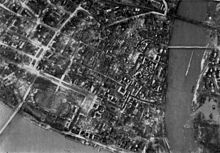Firestorm
A firestorm is the chimney effect in large area fires , in which hot air rises above the seat of the fire due to the development of intense heat and the resulting suction draws fresh air. With this chimney effect, there is thus a positive feedback - the supply of fresh air further fans the fire.
description
Firestorms are favored by the basin-shaped terrain and by a fan-shaped system for the initial fires , with the tip of the fan pointing in the direction from which the wind is coming.
A firestorm can only arise after a large, contiguous source of fire has formed, e.g. B. through the merging of individual small fires, large forest fires or fires of entire city districts and cities. For example, some area bombings in the air war of World War II led to fire storms. The roofs of the buildings were covered by the combined dropping of high-explosive bombs and incendiary bombs , so that the incendiary bombs could ignite wooden components inside. By destroying the window panes, additional air got to the fire sites and enabled the fire to spread rapidly, especially in the case of narrow, winding old town buildings that were largely made of wood. At the same time, the destruction caused by the high-explosive bombs made it more difficult for the rescue workers to advance in the streets blocked by rubble, and there was also the destruction of pipes and the collapse of the (extinguishing) water supply.
In order to optimize the effect of incendiary bombs on inner-city construction methods typical for Germany, replicas of German tenements were built on the Dugway Proving Ground (“ German Village ”) in 1943 . The critical minimum values for the formation of a firestorm are given as 39 kilograms of combustible substance per square meter (8 pounds per square foot) and an area of approx. 1.3 square kilometers (0.5 square miles).
They were also observed following atomic explosions - the two atomic bombs dropped on Hiroshima and Nagasaki and above-ground nuclear weapons tests .
A large firestorm can also spin and then form a cyclone . Fire storms are generally not considered actively extinguishable. They usually only end when the available combustible material has been used up.
The meteorological environment can favor their formation, e.g. B. Before the firestorm in Hamburg in the summer of 1943 it was particularly hot and dry. Heavy bombardments of cities do not necessarily have to generate a firestorm, as the examples in Berlin, Munich and Nagoya show : Even attacks spread over a long period of time could not generate a feedback effect; especially not if there was sufficient extinguishing capacity on site and the development was not dense enough.
Examples
Conventional fires
Well-known historical firestorms are the
- Fire of London in 1666,
- Hamburg fire in 1842,
- Fire of Chicago and the firestorm of Peshtigo ( Wisconsin , USA), in the 1871st
- Kantō earthquake in 1923 killed 140,000.
Bombing raids in World War II

During World War II , there were a variety of area bombing fire storms as part of the aerial warfare , for example (alphabetically):
- in Braunschweig after the air raid on 14./15. October 1944
- in Darmstadt after the air raid on 11/12. September 1944
- in Dresden after the air raids on February 13, 1945
- in Frankfurt am Main after the air raids on 22./23. March 1944
- in Halberstadt after the attack on April 8, 1945
- in Hamburg after the air raids on 27./28. July 1943
- in Hanau after the air raid on March 19, 1945
- in Heilbronn after the air raid on December 4, 1944
- in Hildesheim after the air raid on March 22, 1945
- in Kaiserslautern after the air raid on July 14, 1944
- in Kassel after the air raid on 22./23. October 1943
- in Kobe after the air raid on March 17, 1945
- in Königsberg after the air raid on 29./30. August 1944
- in Koblenz after the air raid on Koblenz on November 6, 1944
- in Leipzig after the air raid on 3rd / 4th December 1943
- in London after the air raid on 29./30. December 1940
- in Lübeck after the air raid on March 28/29, 1942
- in Magdeburg after the air raid on January 16, 1945
- in Mainz after the air raid on February 27, 1945
- in Nagoya after the air raid on Nagoya from 16./17. May 1945
- in Pforzheim after the air raid on 23/24 February 1945
- in Remscheid after the air raid on 30./31. July 1943
- in Stuttgart after the air raid on 12./13. September 1944
- in Tokyo after the US air raid on March 9, 1945
- in Ulm after the air raid on 17./18. December 1944
- in Würzburg after the air raid on March 16, 1945
- in Wuppertal after the air raids on Wuppertal on 29./30. May 1943 and on 24./25. June 1943
A nuclear firestorm was created on August 6, 1945 when the atomic bomb was dropped on Hiroshima .
See also
Web links
Individual evidence
- ^ Firestorms . In: atomicarchive.com
- ↑ Florian Coulmas: Hiroshima: History and Post-History, page 32 . Beck Verlag 2005 ISBN 3-406-52797-3 , 2010, ISBN 978-3-406-58791-7 .
- ^ Sixty Seconds that Will Change the World. Peter Hadfield. First chapters and footnotes.

